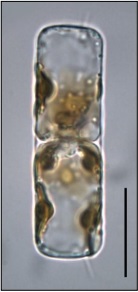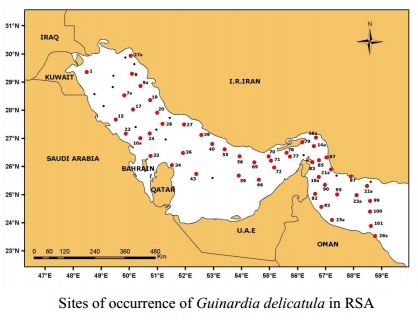Guinardia delicatula Hasle
 Division: Chromophyta
Division: Chromophyta
Class: Bacillariophyceae
Order: Biddulphiales
Suborder: Rhizosoleniineae
Family: Rhizosoleniaceae De Toni
Genus: Guinardia H. Péragallo
Scientific name: Guinardia delicatula (Cleve) Hasle

Cells cylindrical; longer than broad, with a straight or slightly curved pervalvar axis, living singly or united in straight to twisted close-set chains. Intercalary bands numerous, collarlike or with wedge-shaped ends. Valves circular, surface flat, with an asymmetrical lateral rudimentary tooth at the valve margin. Chromatophores numerous, roundish, more or less lobed. Nucleus is usually lying in a central plasma mass, suspended by cytoplasmic strands extending to the cell walls (Cupp, 1943).
The Guinardia genus included 3 species. In Winter 2006 Cruise, small Guinardia delicatula was recorded as the most abundant species. This group contributed occasionally up to 74% of the total phytoplankton abundance; the highest concentration reached 2.5*10/^5 cells/l. High abundance of Guinardia spp. (> 10 5 cells/l) was associated mainly with the waters of the Sea of Oman, and some local peaks occurred off the coast of the UAE and Qatar.
Synonym:
Rhizosolenia delicatula Cleve
References:
Pavillard, 1925: p. 28, Fig. 40 (as Rhizosolenia delicatula);Hustedt, 1930: p. 579, Fig. 328 (as Rhizosolenia delicatula); Cupp,
1943: p. 83, Fig. 44 (as Rhizosolenia delicatula); Crosby and Wood, 1958: p. 522, Pl. 39: 71 (as Rhizosolenia delicatula);
Hendey, 1964: p. 147, Pl. IV: 2 (as Rhizosolenia delicatula); Throndsen et al., 2007: p. 156.
Description:
Cells cylindrical, with almost completely flat valves, rounded only slightly on margins.United in closely set, straight chains. Cells 9-16 µm in diameter, usually about three times as long. Intercalary bands usually difficult to see, ring-shaped. Valve with marginal, short spine which fits into a corresponding furrow or depression on the adjacent cell. Chromatophores two or several large plates, near the girdle wall, more or less crenated or lobed (Cupp, 1943).
Harmful Effect:
Non-toxic bloom-forming species. No harmful incident has been reported, but species may be regarded as potentially harmful during its blooms (Fryxell and Hasle, 2004).
Dimensions:
Cells length 22-27 µm; diameter 11-17 µm.
Distribution:
Neritic, temperate species.
Sites of occurrence in RSA:
In Winter 2006 Cruise, this species was frequently observed, often in large numbers at various sites (refer sites map); maximum abundance (2.5*10^5cells/l) was associated with the southern part of the inner RSA (St. 66). It has been previously reported from Kuwaiti waters of the inner RSA (Al-Kandari et al., 2009).



